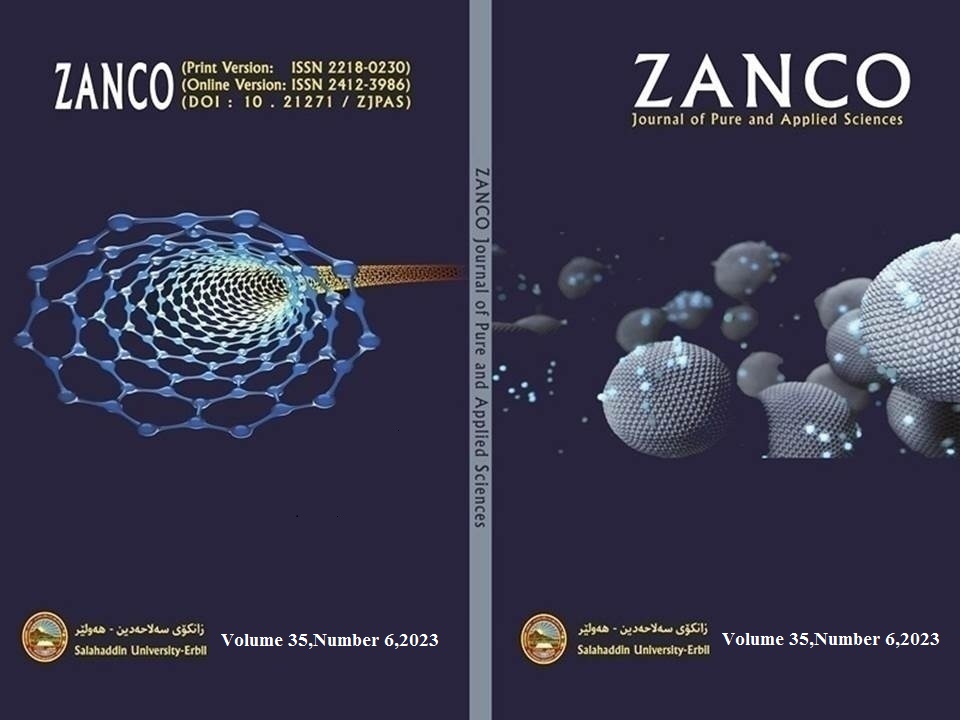Identification of Inhaler Technique Errors Among Asthmatic Patients
DOI:
https://doi.org/10.21271/ZJPAS.35.6.13Keywords:
Inhaler technique, Asthma, pMDI, DPI.Abstract
Proper inhaler technique is a fundamental problem that directly relates to asthma control. Adequate inhaler administration is influenced by a variety of factors, including patient- and device-related factors. Of these factors, device-related errors are more prevalent, and their resolution helps to control illness. A cross sectional, study has been done by using a structured questionnaire form hospital outpatient setting, 70 patients participated using pressurized metered dose inhaler and dry powder inhalers their technique was evaluated face to face, the most common steps of error are detected, and the data analyzed using the SPSS program. Patients who used the proper inhaler technique (7.1% controlled) were in a better control state than those who used the erroneous inhaler technique (28.6% controlled and 62.9% uncontrolled), (p-value 0.011). Overall, the most frequent mistakes were failing to softly exhale before using an inhaler (50%), failing to hold one's breath for five seconds (50%), failing to breathe inappropriately (52.9%), and failing to clean the mouthpiece (65.7%). Specific errors varied across inhaler types, with the most errors observed for pMDI inhalers. In short, using an inhaler correctly is essential for managing and monitoring asthma control. Most people use their inhalers incorrectly, which results in uncontrolled disease.
References
Al-Jahdali, H., A. Ahmed, A. Al-Harbi, M. Khan, S. Baharoon, S. Bin Salih, R. Halwani and S. Al-Muhsen (2013). "Improper inhaler technique is associated with poor asthma control and frequent emergency department visits." Allergy, Asthma & Clinical Immunology 9(1): 8.
Al-Worafi, Y. M. (2018). "Evaluation of inhaler technique among patients with asthma and COPD in Yemen." Journal of Taibah University Medical Sciences 13(5): 488-490.
Arora, P., L. Kumar, V. Vohra, R. Sarin, A. Jaiswal, M. M. Puri, D. Rathee and P. Chakraborty (2014). "Evaluating the technique of using inhalation device in COPD and Bronchial Asthma patients." Respiratory Medicine 108(7): 992-998.
Baddar, S., B. Jayakrishnan and O. A. Al-Rawas (2014). "Asthma control: importance of compliance and inhaler technique assessments." Journal of Asthma 51(4): 429-434.
Basheti, I. A., Y. B. Salhi, M. M. Basheti, S. A. Hamadi and W. Al-Qerem (2019). "Role of the pharmacist in improving inhaler technique and asthma management in rural areas in Jordan." Clin Pharmacol 11: 103-116.
Batterink, J., K. Dahri, A. Aulakh and C. Rempel (2012). "Evaluation of the use of inhaled medications by hospital inpatients with chronic obstructive pulmonary disease." Canadian Journal of Hospital pharmacy 65(2).
Bosnic-Anticevich, S. Z., B. Cvetkovski, E. A. Azzi, P. Srour, R. Tan and V. Kritikos (2018). "Identifying Critical Errors: Addressing Inhaler Technique in the Context of Asthma Management." Pulmonary Therapy 4(1): 1-12.
Braido, F., H. Chrystyn, I. Baiardini, S. Bosnic-Anticevich, T. van der Molen, R. J. Dandurand, A. Chisholm, V. Carter and D. Price (2016). "“Trying, But Failing” — The Role of Inhaler Technique and Mode of Delivery in Respiratory Medication Adherence." The Journal of Allergy and Clinical Immunology: In Practice 4(5): 823-832.
Brennan, V. K., L. M. Osman, H. Graham, A. Critchlow and M. L. Everard (2005). "True device compliance: the need to consider both competence and contrivance." Respiratory Medicine 99(1): 97-102.
Bridgeman, M. B. and L. A. Wilken (2021). "Essential Role of Pharmacists in Asthma Care and Management." J Pharm Pract 34(1): 149-162.
Cho-Reyes, S., B. R. Celli, C. Dembek, K. Yeh and M. Navaie (2019). "Inhalation Technique Errors with Metered-Dose Inhalers Among Patients with Obstructive Lung Diseases: A Systematic Review and Meta-Analysis of U.S. Studies." Chronic Obstr Pulm Dis 6(3): 267-280.
Cho-Reyes, S., B. R. Celli, C. Dembek, K. Yeh and M. Navaie (2019). "Inhalation technique errors with metered-dose inhalers among patients with obstructive lung diseases: a systematic review and meta-analysis of US studies." Chronic Obstructive Pulmonary Diseases: Journal of the COPD Foundation 6(3): 267.
Čukić, V., V. Lovre, D. Dragisic and A. Ustamujić (2012). "Asthma and Chronic Obstructive Pulmonary Disease (COPD) – Differences and Similarities." Materia Socio-Medica 24: 100 - 105.
Deerojanawong, J., V. P. na Sakolnakorn, N. Prapphal, C. Hanrutakorn and S. Sritippayawan (2009). "Evaluation of metered-dose inhaler administration technique among asthmatic children and their caregivers in Thailand." Asian Pac J Allergy Immunol 27(2-3): 87-93.
Dhadge, N., M. Shevade, N. Kale, G. Narke, D. Pathak, M. Barne, S. Madas and S. Salvi (2020). "Monitoring of inhaler use at home with a smartphone video application in a pilot study." npj Primary Care Respiratory Medicine 30(1): 46.
Dudvarski Ilic, A., V. Zugic, B. Zvezdin, I. Kopitovic, I. Cekerevac, V. Cupurdija, N. Perhoc, V. Veljkovic and A. Barac (2016). "Influence of inhaler technique on asthma and COPD control: a multicenter experience." Int J Chron Obstruct Pulmon Dis 11: 2509-2517.
Fink, J. B. and B. K. Rubin (2005). "Problems with inhaler use: a call for improved clinician and patient education." Respir Care 50(10): 1360-1374; discussion 1374-1365.
Giraud, V., F. A. Allaert and N. Roche (2011). "Inhaler technique and asthma: feasability and acceptability of training by pharmacists." Respir Med 105(12): 1815-1822.
Godara, N., R. Godara and M. Khullar (2011). "Impact of inhalation therapy on oral health." Lung India 28(4): 272-275.
Hatley, R. H., J. Parker, J. N. Pritchard and D. von Hollen (2017). "Variability in Delivered Dose from Pressurized Metered-Dose Inhaler Formulations Due to a Delay Between Shake and Fire." J Aerosol Med Pulm Drug Deliv 30(1): 71-79.
Jahedi, L., S. R. Downie, B. Saini, H.-K. Chan and S. Bosnic-Anticevich (2017). "Inhaler technique in asthma: how does it relate to patients' preferences and attitudes toward their inhalers?" Journal of aerosol medicine and pulmonary drug delivery 30(1): 42-52.
Kaplan, A. and D. Price (2018). "Matching inhaler devices with patients: the role of the primary care physician." Canadian Respiratory Journal 2018.
Laube, B. L., H. M. Janssens, F. H. de Jongh, S. G. Devadason, R. Dhand, P. Diot, M. L. Everard, I. Horvath, P. Navalesi, T. Voshaar and H. Chrystyn (2011). "What the pulmonary specialist should know about the new inhalation therapies." Eur Respir J 37(6): 1308-1331.
Lavorini, F., A. Magnan, J. Christophe Dubus, T. Voshaar, L. Corbetta, M. Broeders, R. Dekhuijzen, J. Sanchis, J. L. Viejo, P. Barnes, C. Corrigan, M. Levy and G. K. Crompton (2008). "Effect of incorrect use of dry powder inhalers on management of patients with asthma and COPD." Respiratory Medicine 102(4): 593-604.
Lavorini, F. and O. S. Usmani (2013). "Correct inhalation technique is critical in achieving good asthma control." Primary Care Respiratory Journal 22(4): 385-386.
Lee, H. Y., J. H. Song, H.-K. Won, Y. Park, K. B. Chung, H.-J. Lim, Y. M. Ahn and B. J. Lee (2021). "Comparing inhaler use technique based on inhaler type in elderly patients with respiratory disease." Tuberculosis and Respiratory Diseases 84(1): 46.
Melani, A. S. (2007). "Inhalatory therapy training: a priority challenge for the physician." Acta Biomed 78(3): 233-245.
Melani, A. S. (2021). "Inhaler technique in asthma and COPD: challenges and unmet knowledge that can contribute to suboptimal use in real life." Expert Review of Clinical Pharmacology 14(8): 991-1003.
Melani, A. S., M. Bonavia, V. Cilenti, C. Cinti, M. Lodi, P. Martucci, M. Serra, N. Scichilone, P. Sestini, M. Aliani and M. Neri (2011). "Inhaler mishandling remains common in real life and is associated with reduced disease control." Respiratory Medicine 105(6): 930-938.
Melani, A. S., M. Bonavia, V. Cilenti, C. Cinti, M. Lodi, P. Martucci, M. Serra, N. Scichilone, P. Sestini, M. Aliani and M. Neri (2011). "Inhaler mishandling remains common in real life and is associated with reduced disease control." Respir Med 105(6): 930-938.
Mohd Arif, N., P. Y. Lee, A. T. Cheong and R. N. A. Ananthan (2021). "Factors associated with improper metered-dose inhaler technique among adults with asthma in a primary care clinic in Malaysia." Malays Fam Physician 16(2): 58-66.
Onyedum, C. C., O. Desalu, N. Nwosu, C. Chukwuka, K. Ukwaja and C. Ezeudo (2014). "Evaluation of inhaler techniques among asthma patients seen in Nigeria: An observational cross sectional study." Annals of medical and health sciences research 4(1): 67-73.
Prabhakaran, L., G. Lim, J. Abisheganaden, C. B. Chee and Y. M. Choo (2006). "Impact of an asthma education programme on patients' knowledge, inhaler technique and compliance to treatment." Singapore Med J 47(3): 225-231.
Price, D. B., M. Román-Rodríguez, R. B. McQueen, S. Bosnic-Anticevich, V. Carter, K. Gruffydd-Jones, J. Haughney, S. Henrichsen, C. Hutton, A. Infantino, F. Lavorini, L. M. Law, K. Lisspers, A. Papi, D. Ryan, B. Ställberg, T. van der Molen and H. Chrystyn (2017). "Inhaler Errors in the CRITIKAL Study: Type, Frequency, and Association with Asthma Outcomes." The Journal of Allergy and Clinical Immunology: In Practice 5(4): 1071-1081.e1079.
Ramadan, W. H., A. Sarkis, S. S. Aderian and A. Milane (2020). "Asthma and COPD Patients' Perception of Appropriate Metered-Dose Inhaler Technique." Dose Response 18(2): 1559325820917832.
Rogliani, P., L. Calzetta, A. Coppola, F. Cavalli, J. Ora, E. Puxeddu, M. G. Matera and M. Cazzola (2017). "Optimizing drug delivery in COPD: The role of inhaler devices." Respiratory Medicine 124: 6-14.
Sanchis, J., I. Gich and S. Pedersen (2016). "Systematic Review of Errors in Inhaler Use: Has Patient Technique Improved Over Time?" Chest 150(2): 394-406.
Sanchis, J., I. Gich, S. Pedersen and A. D. M. I. Team (2016). "Systematic review of errors in inhaler use: has patient technique improved over time?" Chest 150(2): 394-406.
Schreiber, J., T. Sonnenburg and E. Luecke (2020). "Inhaler devices in asthma and COPD patients – a prospective cross-sectional study on inhaler preferences and error rates." BMC Pulmonary Medicine 20(1): 222.
Sestini, P., V. Cappiello, M. Aliani, P. Martucci, A. Sena, A. Vaghi, P. A. Canessa, M. Neri and A. S. Melani (2006). "Prescription bias and factors associated with improper use of inhalers." Journal of aerosol medicine 19(2): 127-136.
Usmani, O. S., F. Lavorini, J. Marshall, W. C. N. Dunlop, L. Heron, E. Farrington and R. Dekhuijzen (2018). "Critical inhaler errors in asthma and COPD: a systematic review of impact on health outcomes." Respir Res 19(1): 10.
Vestbo, J., S. S. Hurd, A. G. Agustí, P. W. Jones, C. Vogelmeier, A. Anzueto, P. J. Barnes, L. M. Fabbri, F. J. Martinez, M. Nishimura, R. A. Stockley, D. D. Sin and R. Rodriguez-Roisin (2013). "Global strategy for the diagnosis, management, and prevention of chronic obstructive pulmonary disease: GOLD executive summary." Am J Respir Crit Care Med 187(4): 347-365.
Welch, M. J., H. S. Nelson, G. Shapiro, G. W. Bensch, W. N. Sokol, J. A. Smith and B. M. Parasuraman (2004). "Comparison of patient preference and ease of teaching inhaler technique for Pulmicort Turbuhaler® versus pressurized metered-dose inhalers." Journal of aerosol medicine 17(2): 129-139.
Wieshammer, S. and J. Dreyhaupt (2008). "Dry Powder Inhalers: Which Factors Determine the Frequency of Handling Errors?" Respiration 75(1): 18-25.
Young, H. N., M. E. Len-Rios, R. Brown, M. M. Moreno and E. Cox (2017). "How does patient-provider communication influence adherence to asthma medications?" Patient Education and Counseling 100(4): 696-702.
Downloads
Published
How to Cite
Issue
Section
License
Copyright (c) 2023 Brwa Omer Sharif , Bnar Saleh Ismael, Naza Shakir Shareef Shekhany

This work is licensed under a Creative Commons Attribution 4.0 International License.














